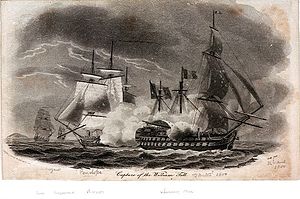HMS Foudroyant (1798)

Capture of the William Tell, by Robert Dodd. Foudroyant is seen in the background.
|
|
| History | |
|---|---|
|
|
|
| Name: | HMS Foudroyant |
| Ordered: | 17 January 1788 |
| Builder: | the dockyard at Plymouth Dock |
| Laid down: | May 1789 |
| Launched: | 31 March 1798 |
| Honours and awards: |
|
| Fate: | Sold 1890. Foundered on Blackpool Sands, 16 June 1897. |
| General characteristics | |
| Class and type: | 80-gun third rate |
| Tons burthen: | 2054 65⁄94 (bm) |
| Length: | 184 ft 8 1⁄2 in (56.299 m)(gundeck) |
| Beam: | 50 ft 6 in (15.39 m) |
| Draught: | 23 ft (7.0 m) |
| Depth of hold: | 22 ft 6 in (6.86 m) |
| Propulsion: | Sails |
| Sail plan: | Full rigged ship |
| Complement: | 650 officers and men |
| Armament: |
|
HMS Foudroyant was an 80-gun third rate of the Royal Navy, one of only two British-built 80-gun ships of the period (the other was HMS Caesar (1793)). Foudroyant was built in the dockyard at Plymouth Dock (a.k.a. Devonport) and launched on 31 March 1798.Foudroyant served Nelson as his flagship from 6 June 1799 until the end of June 1801.
Foudroyant had a long and successful career, and although she was not involved in any major fleet action, she did provide invaluable service to numerous admirals throughout her 17 years on active service. In her last years she became a training vessel for boys.
Her designer was Sir John Henslow. She was named after the 80-gun Foudroyant, which Swiftsure and Monmouth, both 70-gun ships, and Hampton Court (64 guns), had captured from the French on 28 February 1758.
Foudroyant was a one-off design. She followed French practice of favouring large two-decked, third rates mounting 80 guns rather than the typical British preference for building three-decked second-rate ships mounting 98 guns. The two ship types, despite the difference in absolute gun numbers, had similar gun power but the British thought the second rate had a more imposing appearance and some advantages in battle, while they considered the 80 gun ship as usually faster and less 'leewardly'.
Foudroyant was first commissioned on 25 May 1798, under the command of Captain Thomas Byard. On 12 October Foudroyant was with the squadron under Captain Sir John Borlase Warren in Canada engaged a French squadron under Commodore Jean-Baptiste-François Bompart in the Battle of Tory Island. The British captured the French ship of the line Hoche and four of the eight French frigates. Foudroyant was only minimally engaged, though she did suffer nine men wounded, and went off in unsuccessful pursuit of the French frigates that had escaped. (Other British warships captured two of these frigates; two frigates and a schooner escaped completely). In 1847 The Admiralty awarded the Naval General Service Medal with clasp "12th October 1798" to all surviving claimants from the action.
...
Wikipedia
